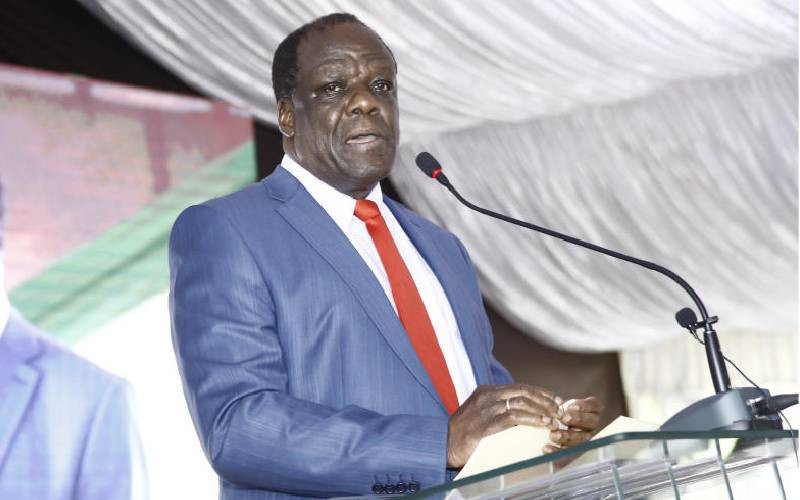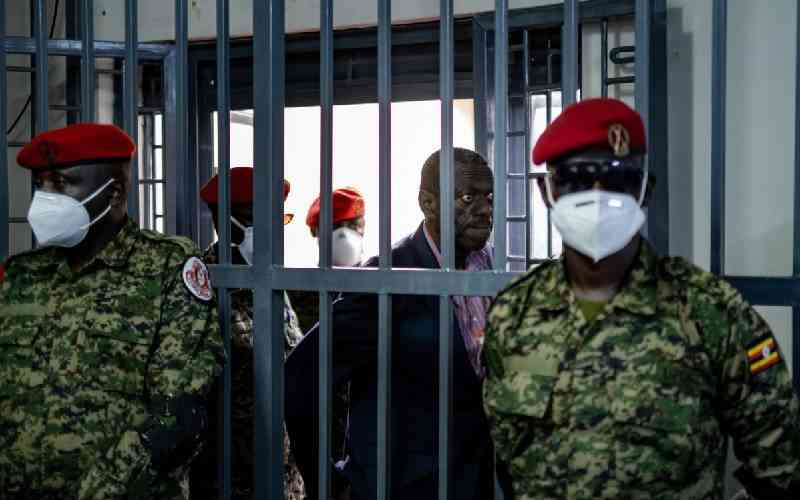 |
|
Devolution Cabinet Secretary Anne Waiguru (centre), Kisii Governor James Ongwae and Public Service Commission Chairperson Margaret Kobia. RIGHT: Salaries and Remuneration Commission Chairperson Sarah Serem. [PHOTOS: FILE/STANDARD] |
Kenya: The pain, it seems, is not over for civil servants as the Government embarks on a restructuring mission that could see thousands sent home later this year.
Last week, the Government appointed a team to determine the civil service staffing needs, suggesting possible lay-offs. Fourteen years ago, Johnston Oduor, an Engineer, nearly clinched a senior management post in a State parastatal. But his dream was cut short by Government’s austerity measures, where he, and 20,000 others, were left jobless after his post was waved off.
Soon, those he left behind may suffer the same fate as officials from the Ministry of Devolution and Planning, Salaries and Remuneration Commission, Transition Authority, Public Service Commission, Union of Kenya Civil Servants and the Council of Governors auditing the public service, complete their task in November.
The process will set the stage for staff redeployment, transfers and elimination of ghost workers, aimed at cutting the bloated public wage bill, which currently stands at more than Sh500 billion annually.
Devolution and Planning Cabinet Secretary Anne Waiguru said the Government had embarked on a job evaluation exercise to find out what positions and number of people it needs to effectively carry out its mandate.
Public Service Commission chair Prof Margaret Kobia, tasked with hiring, redeploying and sacking public servants said the exercise would be followed by transfer of employees whose roles were devolved to the counties. The exercise will see a number of staff moved to other departments, ministries and counties where there is shortage of manpower while those whose services are considered non-essential will be sacked. However, the Government will set up a mechanism to compensate those affected.
What the Government is not telling Kenyans is the painful fact that it wants more than 50,000 employees to exit the civil service from November when the evaluation ends. The plan, according to sources in Government, has been on the cards since the Jubilee administration took over office.
Rampant corruption
Deputy President William Ruto last year sparked public uproar when he said the Government planned to send home more than 100,000 bottom level civil servants. But what he failed to recognise is that mainstream civil service has more people in higher job cadres than support staff.
The DP said it was unsustainable to continue spending more than Sh500 billion on salaries alone while the Government struggled to finance development projects. This means more than half of the revenue goes to paying salaries and allowances of public service employees. Analysts say this is unsustainable.
And then, there was a plan mooted in May last year to send home 50,000 civil servants by the then ministry of State for Public Service. The Government had proposed an exit package of Sh360, 000 for junior staff and Sh480,000 for senior civil servants, a plan that was rejected by the Union of Kenya Civil Servants. If the Government lays off public servants, it would be the third time in as many decades that a huge number of civil servants would be laid off. Between 1996 and 2000, slightly more than 40,000 civil servants lost their jobs in the International Monetary Fund (IMF) -backed retrenchments during the infamous Structural Adjustments Programme.
Kenya was then struggling to mend its relations with foreign financiers, who had cut ties with the Kanu regime over rampant corruption and gross mismanagement of public resources. The sacked civil servants got a Sh40,000 severance package, culminating to prolonged legal battles with the Government.
Thereafter, at the turn of the century, the Kanu administration’s ‘Dream Team’ led by conservationist Richard Leakey sent home another 23,446 civil servants. However, the wage bill reprieve was short-lived. Soon after former President Mwai Kibaki took over in 2002, the wage bill started going up rapidly. Policy analysts say coalition politics are largely to blame for the meteoric rise wage bill in the last decade. Dickson Khainga, senior Policy Analyst at Kenya Institute of Public Policy Research and Analysis said the IMF-led Structural Adjustments Programme which focused on stabilisation, privatisation and liberalisation, only worked in terms of stabilisation, however, key indicators of living standards like poverty, access to education and health services, were a big failure.
“This has been widely acknowledged even within the international development fraternity. Some policies such as cost sharing in education were disastrous,” he said. “In 2003, Kenya reversed the policy and introduced free primary education. We have seen remarkable improvements in enrollment, putting the country back on the path to develop the required human capital for long term development.”
Stay informed. Subscribe to our newsletter
Regarding the civil service reforms, he says rationalisation helped to reduce the number of central government employees from about 269,000 employees in 1992 to about 190,000 in early 2000’s. However, what has changed overtime is the composition of the public sector. The overall size remains largely the same. For instance in 1992, the entire public sector employed about 693,000 compared to about 688,000 in 2013.
The real turning point was the grand coalition formed in 2008 that brought about the ‘grand coalition’ and with it the exponential growth in public sector wage, which grew 100 per cent the short span between 2008 and 2013. But after former President Mwai Kibaki took up leadership, the number of government employees started going up, especially after 2004. But it is after the contested 2007 elections that birthed a Kibaki-Raila grand coalition government that was the real turning point for the public sector wage bill. During the five years to 2013, the wage bill doubled from Sh240.5 billion in 2008/09 financial year to Sh458 billion in 2012/2013.
This was on the back of each side of the political divide pushing to have their own occupy some office, which saw the cabinet grow to over 40 ministries, some of them departments hived off from ministries as the leaders clamoured to create room for their cronies.
This bloated workforce, economists say has to be cut. “IMF structural programmes of the 1990s belonged to another era and should not colour what is a very clear and present danger; that being our Government costs too much and delivers too little,” said Aly Khan Satchu, CEO at Rich Management.
But then, other analysts say retrenchment might not be the quick fix for the wage bill problems. “It would be rather premature to jump to retrenchment as the solution. There are several challenges associated with the transition to devolved governance systems that require a ‘holistic’ approach to achieve an efficient and coherent public sector regarding the operations of the 48 governments,” said Khainga.
He says the best way forward is to get a holistic diagnosis and approach to reform because ‘Kenya is undergoing a transition and there are a wide range of challenges that need to be addressed systematically’.
Through constitutional requirements, National Government’s ministries have been reduced, some functions have been devolved and now there are 48 governments, with varying indicators of wage bill sustainability, and even skills and structures.
“There are wide range of challenges regarding capacity and institutions such as weak and nascent systems of public financial management, and the need to achieve coherence in inter-governmental relations and coordination for efficient and effective service delivery. Retrenchment might just be one of the policy options.”
Satchu says the Government should put together exit packages and bite the bullet because Kenya cannot support this super-sized administration.
 The Standard Group Plc is a
multi-media organization with investments in media platforms spanning newspaper
print operations, television, radio broadcasting, digital and online services. The
Standard Group is recognized as a leading multi-media house in Kenya with a key
influence in matters of national and international interest.
The Standard Group Plc is a
multi-media organization with investments in media platforms spanning newspaper
print operations, television, radio broadcasting, digital and online services. The
Standard Group is recognized as a leading multi-media house in Kenya with a key
influence in matters of national and international interest.
 The Standard Group Plc is a
multi-media organization with investments in media platforms spanning newspaper
print operations, television, radio broadcasting, digital and online services. The
Standard Group is recognized as a leading multi-media house in Kenya with a key
influence in matters of national and international interest.
The Standard Group Plc is a
multi-media organization with investments in media platforms spanning newspaper
print operations, television, radio broadcasting, digital and online services. The
Standard Group is recognized as a leading multi-media house in Kenya with a key
influence in matters of national and international interest.









